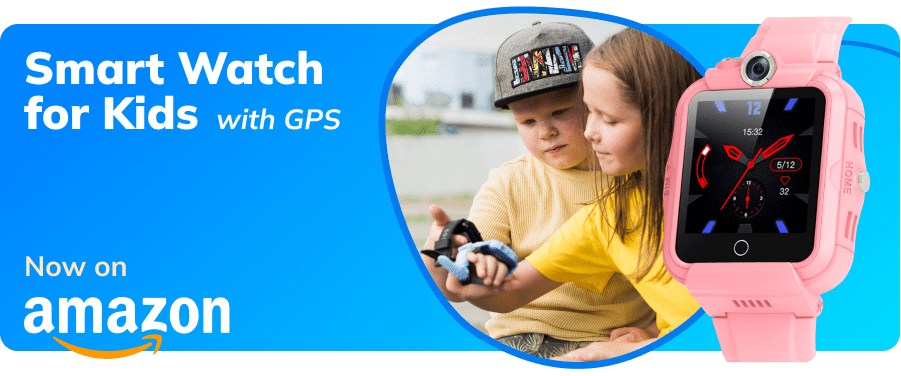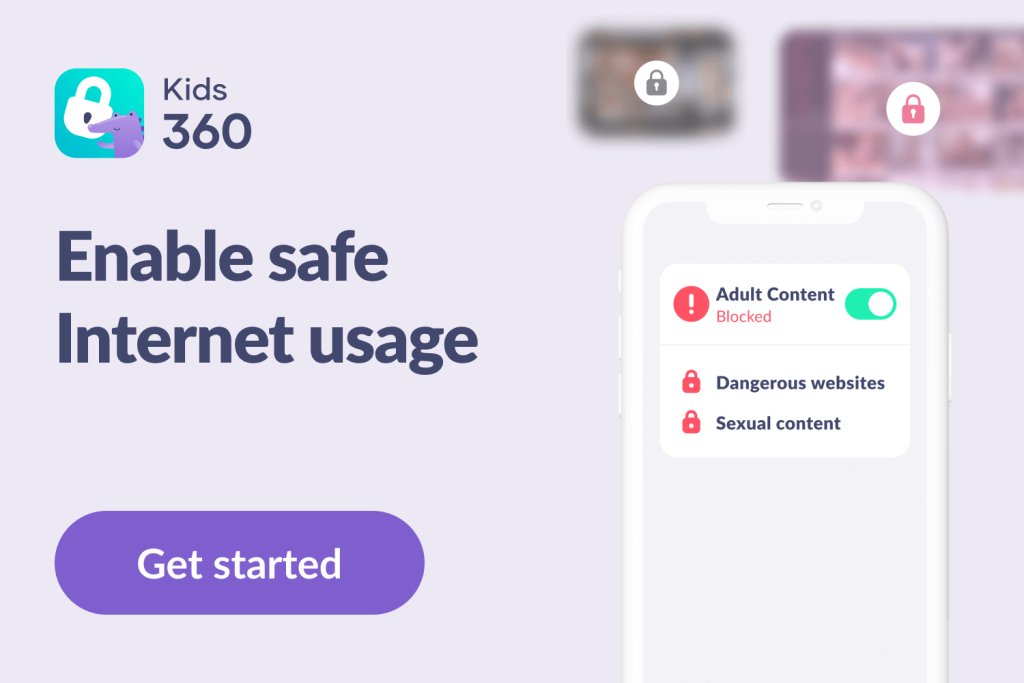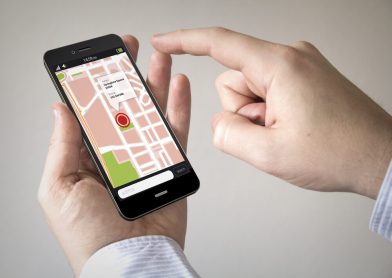Forbidden Click: What to Do If Your Child Has Seen Adult Content

How to turn an accidental encounter with adult videos and inappropriate content online into an honest and trusting conversation about difficult feelings.
The average age when kids first come across pornography is around 12–13. Research shows that about 90% of children aged 8–16 have seen sexual content at least once, and nearly half of tweens between 12 and 14 say they’ve watched it regularly.
Watching porn for kids can leave a lasting negative impact on their mental health and future relationships, which is why it is so important for parents to be aware of what their children are watching online.
Dr. Sarah Caldwell, child psychologist, explains:
“Pornographic content today is just one click away. The topic isn’t new, but the ease and speed of access are. There’s no point in blaming yourself or your child for seeing it—what really matters is what you do next.”
The Findmykids Blog editorial team set out to find the answer to this question.
Contents:
- Your Child Has Seen Porn and Is Asking Questions. What Now?
- “I Know My Child Has Seen It. What Should I Do?”
- If You Know They’ve Seen Adult Content, but It Didn’t Happen in Front of You
- Can You Prevent Kids from Seeing Adult Content?
- Why Ages 7–12 Are Especially Vulnerable
- Why This Conversation Matters: The Impact of Pornography on a Child’s Mind
- FAQs
Your Child Has Seen Porn and Is Asking Questions. What Now?

Rawpixel.com/Shutterstock
First, don’t panic. Take a deep breath—this is not something that makes you a “bad parent,” and it’s not something your child is alone in. However, how you react in this moment will shape what happens next: it can either strengthen or damage the trust between you.
Anger and shame are natural, but they won’t help. Yelling, punishing, or shaming will only push your child away—and once trust is broken, rebuilding it is incredibly hard. Approach the situation calmly, with empathy and curiosity.
Listen Without Interrupting
Give your child space to tell you what happened, in their own words. Your goal is not to control the story, but to understand it. Stay calm and let them talk—the hardest part (the exposure) has already happened. Now it’s time to help them process what they saw.
Acknowledge Their Courage
It takes courage for a child to admit they’ve seen something like this—and to talk about it with a parent. Thank them for being honest. It shows they trust you and feel safe enough to share something uncomfortable.
Help Them Name Their Feelings
Say something like, “I can see that you’re confused/embarrassed/scared. That’s completely normal. I’d feel that way too.”
This helps them recognize and validate their emotions instead of burying them under shame.
Reassure Them: It’s Not Their Fault
In about 60% of cases, kids stumble upon adult content by accident—through pop-ups, messages, or links shared by friends. Even when they search for it intentionally, it’s usually driven by curiosity and a desire to “feel older.” That’s normal for tweens exploring identity and maturity.
You can say, “It’s not your fault—sometimes kids come across these things by accident or because they’re curious. Either way, you didn’t do anything wrong.”
Learn the Context, Not the Details
Gently ask how it happened—when, where, and how they found the content. Did a friend show it to them? Did they come across it while playing online or scrolling through social media platforms like TikTok or YouTube? This will help you take practical steps to protect them next time, such as blocking harmful sites, setting stronger privacy filters, or checking their social media settings.
But avoid probing for explicit details. Your child doesn’t need to replay what they saw—and you don’t need that level of information. Focus on what they felt. Ask questions like, “How did that make you feel?”
If the topic feels too awkward, sometimes a parent of the same gender can take the lead. You can be honest about that, “This isn’t an easy topic, but it’s about your safety. Let’s talk it through.”
⠀
Give them permission to ask anything—and make it clear that feeling curious or even aroused is normal.
Answer Simply and Directly
If your child asks questions, stick to the facts—but keep it age-appropriate. Explain that, “Porn isn’t real life. It’s actors, scripts, and editing. It’s not a guide for real relationships.”
Dr. Tania Scott, a licensed family therapist, adds, “Kids need to understand that pornography is a performance. It’s filmed, edited, and designed to grab attention—not to show healthy intimacy. Bodies are made up, emotions are faked, and the focus is rarely on consent or respect.”
Your goal is to help your child see that what they saw isn’t reality.
Explain What “Adult Content” Means
You might say, “Every movie, video, or book has an age rating—it tells us who it’s meant for. Some things are for kids, some for teens, and some only for adults. ‘Adult content’ means it’s not appropriate for kids because it can be confusing or upsetting.”
For younger kids (under 10), you can skip the word pornography altogether and just use “videos for adults.” For ages 10–12, you can use the term if they ask about it—just explain it simply and without judgment.
Reassure them by saying, “It’s okay if it felt weird or uncomfortable. That’s a normal reaction. If you ever see something that upsets or confuses you, come to me—I’ll help you figure it out. I won’t be mad.”
This shows that they can always come back to you later if questions resurface.
Keep the Focus on Meaning, Not the Mechanics
If your child asks how relationships “really” work, don’t dive into the physical side first. Instead, talk about consent, respect, and communication. Say something like, “Real relationships are about mutual respect, caring, and listening to each other. Nothing should happen without both people wanting it.”
Shift the Conversation Toward Real Relationships
Sex is part of adult relationships—but not the whole story. The best thing you can do is redirect curiosity toward the emotional side of connection.
Talk about love as friendship, care, and teamwork. Use examples from movies, books, or even your own relationship. “See how they laugh together, help each other, and solve problems? That’s what love really looks like.”
You can also ask reflective questions like, “What do you think people like about each other besides looks? What’s the difference between friendship and dating?”
That way, the conversation becomes a dialogue, not a lecture.
Satisfy Their Curiosity About the Body
Kids will stay curious—and that’s okay. Help them find accurate, age-appropriate resources —educational books, anatomy guides, or reputable websites—on puberty and relationships in a healthy way. Review them first, then offer them to your child. Reassuring statements, like “You can always ask me questions if you’re unsure. I’ll help you figure it out,” can be impactful.
Dr. Caldwell recommends a few excellent resources for parents and tweens:
- The Care and Keeping of You by Valorie Schaefer
- Guy Stuff: The Body Book for Boys by Cara Natterson
- Sex Is a Funny Word by Cory Silverberg
- Growing Up Great! by Scott Todnem
These can open up safe, fact-based conversations and normalize healthy curiosity.
Watch for Changes in Behavior
Some signs that a child might still be struggling after exposure to adult content include:
- Withdrawal or unusual shyness
- Nervousness or trouble sleeping
- Acting out or imitating sexual behavior
- Irritability or aggression
If you notice these patterns, it’s a good idea to talk to a child psychologist who specializes in digital well-being or trauma-informed care.
Give Them Space
If your child gets tense or shuts down mid-conversation, step back. Say something like, “That’s okay—we can talk about it later when you feel ready.”
The goal isn’t to push them into talking, but to show that you’re there when they are ready.
Remember: It’s Not One Talk — It’s a Series
This isn’t a single “birds and bees” conversation. It’s an ongoing dialogue that evolves as your child grows. The goal is to help them build internal anchors—safety, respect, consent, and empathy—that will guide them as they encounter more adult ideas online and offline.
Your job is not to control everything they see. It’s to be their trusted source of answers—someone they can always come back to when the world feels confusing.
As your child grows older and starts taking sex education classes in school, they may have even more questions about what they may have seen. The conversations and questions could grow heavy, discussing topics of child sexual abuse, child pornography, sexual abuse in relationships, and more. It’s important as parents to be prepared for these serious conversations and have a plan for what to say so you’re not caught off guard.
“I Know My Child Has Seen It. What Should I Do?”
You’re probably wondering what to do if your child sees porn. If your child comes across adult content right in front of you, the first step is to stay calm. The more emotion you show in your voice or facial expression, the more attention your child will give to what they just saw.
Use a neutral, even tone and say something like, “That’s an adult video (or picture). It’s not meant for kids.”
Then gently redirect their attention to something more engaging or comforting—a toy, an activity, or just a different topic.
If your child seems fixated on what they saw—replaying the image in their mind or asking questions—help them talk about their feelings and describe what they’re thinking. Processing the experience out loud will help the brain release it and reduce anxiety.
If You Know They’ve Seen Adult Content, but It Didn’t Happen in Front of You
So, your child saw porn, what to do next is an important step that will set the tone for how they feel about speaking with you about sensitive topics. Act—but in a way that preserves trust.
Don’t Try to “Catch Them in the Act”
That kind of approach makes a child feel cornered and ashamed. Instead, choose a calm, relaxed setting for your talk.
Avoid starting with something like “We need to talk.” Even adults tense up when they hear that phrase—imagine how it sounds to a child.
Try bringing up the topic casually, during a car ride, a walk, or while cooking dinner together. Psychologists note that car conversations often turn into the most honest ones—the lack of eye contact helps reduce embarrassment.
Otherwise, follow the same basic principles as when a child tells you about it voluntarily: calm tone, empathy, curiosity, and respect.
Can You Prevent Kids from Seeing Adult Content?
The older your child gets, the less intrusive the control should be. Installing secret parental blocks or taking away the phone after every incident won’t build trust. But there are steps you can take that do help:
- Talk about online safety rules.
Explain that if they see something weird, scary, or confusing online, they should close the window immediately and tell an adult. Remind them never to share personal information, photos, or location details with strangers on the internet. Encourage them to ask before downloading new apps or joining unfamiliar chats or challenges. - Teach critical thinking.
Explain that not everything online is true—that content can be exaggerated, manipulative, or designed to shock. Help them practice questioning what they see, hear, and read. - Stay curious about their interests.
Ask open questions: What videos or creators do you like? What was the most interesting thing you saw online this week? How did it make you feel? The goal is not surveillance—it’s connection. If these talks become routine, your child will be more likely to come to you when something really happens. - Create family accounts and child profiles wherever possible—streaming platforms, app stores, or devices—to make browsing safer by default.
- Use digital tools to block or filter explicit content.
apps like Kids360 or Findmykids, browser extensions, and built-in parental controls on every smartphone or router can help filter what your child sees. For younger kids, parents can set up screen time limits and filtering schedules themselves. For older ones, it’s better to discuss and agree on the rules together—that way, it feels like teamwork, not control.
Also, watch your child’s behavior and mood. Changes in sleep, appetite, mood, or social activity can signal stress or anxiety. Don’t hesitate to reach out to a therapist—sometimes kids find it easier to talk about sensitive experiences with another trusted adult.
Why Ages 7–12 Are Especially Vulnerable
According to child psychologist Dr. Sarah Caldwell, kids between 7 and 12 are particularly sensitive to adult imagery.
At this age, the brain is still developing, and emotional self-regulation is limited. A child may not fully understand what they’re feeling, so reactions can vary: from shock or fear to curiosity or even arousal.
These images can “stick” in memory and affect daily life. It’s not always a trauma, but there’s a risk—and the best way to reduce it is through calm, open discussion.
Why This Conversation Matters: The Impact of Pornography on a Child’s Mind
Talking about sex is rarely easy—it can feel awkward, uncomfortable, or taboo. But if your child has already seen explicit content, the conversation is necessary. Without your guidance, they’ll be left alone with confusion, guilt, and unanswered questions.
Children under 10 simply aren’t ready for direct information about sex. Pediatric sexologist Dr. Olivia Warren warns: accidental exposure can lead to anxiety, nightmares, or premature curiosity about sexuality—in other words, a traumatic experience.
For ages 10–12, things get more complex. They’re curious about their bodies and relationships but can’t yet tell fantasy from reality. Exposure to porn can:
- Trigger shame and embarrassment
- Distort ideas about sexuality and relationships
- Lower self-esteem and body confidence
Dr. Tania Scott, family psychologist, explains, “Real relationships require emotional investment, attention, and responsibility. If a teen doesn’t understand that, the mechanical, emotionless scripts shown in pornography can become addictive—and prevent them from building genuine connections.”
Dr. Sarah Caldwell adds, “The problem with porn isn’t just explicitness—it’s the false image of intimacy it creates. There’s no consent, no respect, no emotional connection. Everything looks easy and consequence-free. Teens—especially younger ones—can’t view that through an adult lens yet.”
That’s why they need anchoring conversations with parents about love, trust, and consent. Remind them that real relationships are built on empathy, care, and mutual respect—not what’s shown on a screen.
Yes, these talks may feel awkward. But silence leaves your child alone with their confusion. Talking builds resilience.
Children grow—and that’s normal. They’ll come across all kinds of content—and that’s inevitable. When they’re small, you can filter their digital world. As they grow older, your task is to teach them how to filter it themselves—to think critically, question what they see, and know they can always come to you for clarity.
As uncomfortable as it may feel, your child will learn about intimacy sooner or later. And it’s always better that their first understanding comes from you—calmly, safely, and without shame.
Your job isn’t to keep everything “under lock and key.” It’s to help your child develop a healthy, confident, and respectful view of sexuality.
FAQs
How do I stop my child from seeing inappropriate content?
Parental control apps are helpful in blocking websites that may present adult content. Adding some pop-up blockers can also keep your child from seeing inappropriate content. One of the most effective apps is Kids360, which allows parents to see exactly what their children see online and put parental controls on certain websites.
What do I do if my child has inappropriate pictures?
If you find inappropriate pictures on your child’s devices, it’s important to have a calm but serious conversation with them about the pictures. Explain that these photos are not meant for children and that they are meant for adults. Be honest and transparent as you explain why they are inappropriate. You can ask questions about where they found the photos and why they saved them.
What to do when you find inappropriate things on your child’s phone?
Understanding how to talk to your child about porn, especially when your child accidentally saw porn or intentionally watched it, can set the tone for how they talk to you about sensitive subjects. The first thing to do is stay calm. Never shame your child for seeing this type of content. Instead, calmly and honestly explain porn to a child. Mention that it is for adults and that it is performative—it is not real life. Have an open discussion about why they shouldn’t be watching this type of content.
Cover image: Rawpixel.com/Shutterstock
Проверьте электронный ящик




















